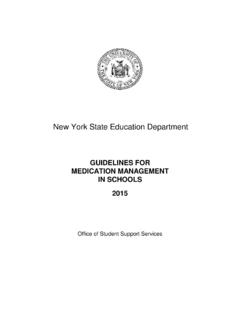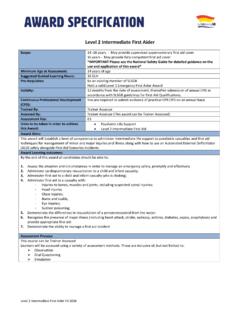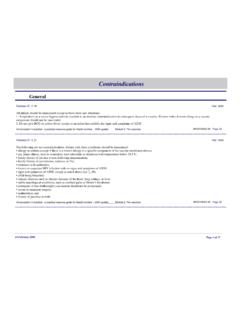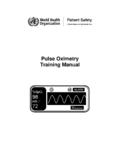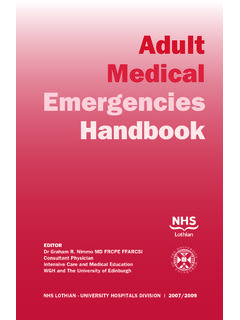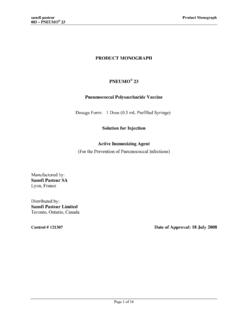Transcription of Emergency Medical Technician-I Scenarios for Training
1 Emergency Medical Technician-I Scenarios for Training Revised March 1, 1995 Alaska Emergency Medical Services Section Division of Public Health Department of Health and Social Services Box 110616 Juneau, AK 99811-0616 (907)465-3027 Table of Contents Basic Medical Assessment ..1 Basic Trauma Assessment ..2 Medical Patient with Abdominal Pain .. 3 Bleeding Control .. 4 Adult Cardiac Arrest .. 5 Sick Child with Respiratory Difficulty .. 6 Gunshot Wound to Thigh .. 7 Chest Injuries Following Fall .. 8 Fractured Clavicle .. 9 Conscious Patient with Head Injuries .. 10 Unresponsive Head Injury Patient.
2 11 Responsive Diabetic Patient .. 12 AED Use .. 13 Pediatric Poisoning .. 14 Cardiac Chest Pain with No Nitroglycerin .. 15 Cardiac Chest Pain with Nitroglycerin .. 16 Adult Respiratory Distress, No Medications .. 17 Adult Respiratory Distress, Patient has Inhaler .. 18 Fractured Femur .. 19 Anaphylaxis, with Epinephrine Autoinjector .. 20 Overdose Patient .. 21 Fractured Femur and Multiple Trauma .. 22 Removal of Stable Patient From Vehicle .. 23 Rapid Removal of Unstable Patient from Vehicle .. 24 Gunshot Wound to Chest .. 25 Patient with Stab Wound to Abdomen .. 26 Impaled Object.
3 27 Burns of Upper Extremity .. 28 C-Spine Immobilization, Neurological Deficit .. 29 Motorcycle/ATV Crash with Helmet .. 30 Do Not Resuscitate .. 31 SCUBA Diving Emergency .. 32 Multiple Casualty Incident .. 33 Instructions for Those Taking Scenario Based Practical Examinations .. 34 Introduction These Scenarios were developed for use in EMT-I Training programs in Alaska. They are based on the Alaska Skill Sheets and the 1994 Revision of the United States Department of Transportation EMT-Basic curriculum. The Scenarios may be used with other curricula with little or no modification.
4 This document is not confidential and it may be distributed as the instructor deems educationally warranted. Instructors are not compelled to use these Scenarios . Rather, they are offered as a way of increasing the number of practical experiences available to students throughout the course. The initial assessment Scenarios are designed to be completed by one person. In later Scenarios , the student will serve as team leader and be required to coordinate the efforts of two other rescuers. Since students will be working with many individuals throughout their tenure as EMTs, it is important that they develop self reliance and can function in each of the roles required of EMS team members.
5 Scenarios in EMT classes should become progressively more challenging. In most cases, the age and sex of the patient is not specified in the scenario. This makes it possible for the instructor to modify the scenario to use available resources. Moulage requirements are minimal. This was done to decrease the time it would take to set up each scenario. Instructors who have the resources are encouraged to make the Scenarios as realistic as possible. Students should understand that they should assess and treat the patient in accordance with the instructions found on page 34. They should also understand that vital signs should actually be taken and that the proctor will provide revised vital signs, if necessary.
6 In all cases, the students should use appropriate body substance isolation measures. The scene is safe in all Scenarios , even those in which law enforcement personnel would generally be expected to be on-scene to ensure safety. This was done to facilitate scenario development and delivery. EMT students should be cautioned in class, however, to take special care to make sure the scene is safe when responding to calls involving interpersonal violence. Whenever possible, the skills should be actually performed, not verbalized. This is consistent with field practice and is important for the education of the EMT student.
7 Likewise, the position of the patient should be changed between Scenarios so that students get experience in taking care of patients in a variety of positions. The proctors used for the Scenarios should be experienced Medical personnel who are capable of providing feedback to students in a coherent, nonthreatening and educational manner. In some Scenarios , the proctor also assumes the role of a bystander, family member, etc. If resources permit, you should have another person fill the additional role so the proctor can concentrate on the individual's performance. Students should understand the concept of "'standing orders" and, for the purposes of these Scenarios , they should assume they have standing orders to administer glucose, activated charcoal, nitroglycerin, and bronchodilator inhalers in accordance with the Alaska Skill Sheets.
8 If the students simulate communications with the Emergency department and ask for advice on patient treatment, they should be told to continue current care and transport as soon as possible. In the proctor's discretion, additional treatment may be recommended as an educational strategy. Administration of medications may be authorized in accordance with the service's standing orders, or the relevant Alaska Skill Sheets. Whenever possible, the scenario should include a patient report given to the Medical facility or incoming Medical personnel. Instructors should feel free to modify the Scenarios to better meet their student's needs, keeping in mind that the Scenarios should be challenging but achievable.
9 If you have Scenarios you wish to contribute to this booklet, or you have questions, contact Matt Anderson at the Alaska Emergency Medical Services Section (465-3027). Basic Medical Assessment Purpose: This scenario provides the student with an opportunity to assess a conscious Medical patient in an organized and comprehensive manner. Staff: 1 student, 1 proctor and 1 patient. Equipment: Blood pressure cuff, stethoscope, watch, penlight, run sheet. Moulage: None Scenario: You are called to the home of a patient who has recovered consciousness after fainting.
10 The scene is safe. Vital Signs: As found on the simulated patient. Information: Alert and oriented but slightly anxious Denies pain Unconscious for only a few minutes History of cardiovascular disease No medications

